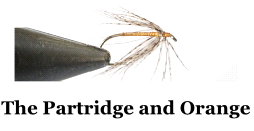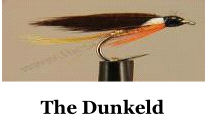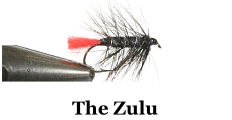
WET FLIES
BACK TO TABLE OF CONTENTS
Wet flies are designed to be fished sub-surface, so they tend to be tied slimmer than dry flies because they do not need to hold air to float. We want these flies to sink. They are one of the oldest forms of fly but these days seem to have fallen out of fashion. They can be used either as a reproduction of an actual aquatic insect - called an imitator - or as a general representation of a small fish or vertebrate, using movement as its best quality - called an attractor. As you will read, wet flies have many uses and should still form an important part of every fly fisherman's armoury. One of the main ideas of the imitative wet fly is to simulate a fly in its hatching stage as it moves up through the water column, or they can be made with a wing to simulate a mated fly as it dives to deposit its eggs. This video shows how to make a March Brown wet fly with a wing.
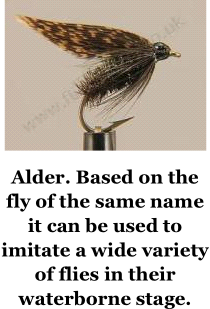 A floating line can be used with wet flies in shallow water. This may require some weight to be incorporated into the wet fly to get the fly down to the fish. This must be done during the fly's construction with a little lead wire tied into the under body. Alternatively a slow sinking line can be used, when there is no need to weight the fly as well. I prefer to use the slow sink line, as I can use the counting method to have a good idea at what depth my flies are fishing. I can repeat the count and therefore the depth if I get a bite. Additionally, an unweighted fly will be sitting at more or less the same depth as the main line, so there is a more direct contact between fisherman and fly. A weighted fly will drop and cause a distinct angle between main line and fly, which must be straightened before any strike becomes effective. See the section on Intermediate Lines to get more information on the counting method.
A floating line can be used with wet flies in shallow water. This may require some weight to be incorporated into the wet fly to get the fly down to the fish. This must be done during the fly's construction with a little lead wire tied into the under body. Alternatively a slow sinking line can be used, when there is no need to weight the fly as well. I prefer to use the slow sink line, as I can use the counting method to have a good idea at what depth my flies are fishing. I can repeat the count and therefore the depth if I get a bite. Additionally, an unweighted fly will be sitting at more or less the same depth as the main line, so there is a more direct contact between fisherman and fly. A weighted fly will drop and cause a distinct angle between main line and fly, which must be straightened before any strike becomes effective. See the section on Intermediate Lines to get more information on the counting method.
 The idea of presenting a fly subsurface makes the wet fly ideal to fish in the loch style method, where the boat is continuously moving forward as it is pushed by the wind. This method has the added advantage of continuously moving you over new water, so there is less likelihood of the fish being spooked by previous line splashes or movement. Loch style fishing is explained in depth in the section on Going Afloat. With the short casts of this method, the shallow presentation and dibbling hold of the fly at the surface, the flies only have a short time to sink, so the method and the fly fit well together. Many loch style fishermen may put wet flies on the point and middle droppers, with a large attractor such as a muddler on the top dropper.
The idea of presenting a fly subsurface makes the wet fly ideal to fish in the loch style method, where the boat is continuously moving forward as it is pushed by the wind. This method has the added advantage of continuously moving you over new water, so there is less likelihood of the fish being spooked by previous line splashes or movement. Loch style fishing is explained in depth in the section on Going Afloat. With the short casts of this method, the shallow presentation and dibbling hold of the fly at the surface, the flies only have a short time to sink, so the method and the fly fit well together. Many loch style fishermen may put wet flies on the point and middle droppers, with a large attractor such as a muddler on the top dropper.
Another ideal use for the wet fly is when the trout are feeding on pin fry near the top of the water - sometimes it is almost as if it is raining as the fry jump to avoid the hunting trout. A silver or white bodied wet fly, such as the butcher, pulled through the shoal can have a dramatic effect. There is no reason why you cannot put a wet fly on the top and middle droppers with a lure on the point in these circumstances, using a faster retrieve to emulate the escaping fry.
Turning to river fishing, the wet fly again has its own niche. Here, the line is cast across the current while the angler faces downstream. The idea is to allow the fly to move slowly down and across the current, swinging out across the stream. Because wet flies are tied with a wing, are often palmered and sometimes have legs as well, the action of the current will cause these parts of the fly to move and pulsate giving life and action to the fly. This video shows a wet fly river fishing technique.
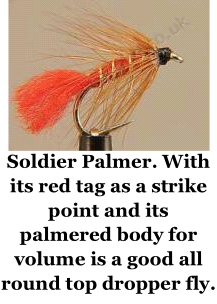 Palmering is just a nice word to describe the way a feather is wound down the whole of the shank of the hook during construction. Each hackle of the feather sticks straight out and gets bent by the resistance of the water, giving lots of action to the fly as it moves through the water. If you decide to have a go at palmering your fly just remember to trim back the hackles in the bend of the hook or they may interfere with the hook point when you strike. There is more information about hackling and palmering in the Fly Tying Section. The construction of the Soldier Palmer pictured here is described in this video.
Palmering is just a nice word to describe the way a feather is wound down the whole of the shank of the hook during construction. Each hackle of the feather sticks straight out and gets bent by the resistance of the water, giving lots of action to the fly as it moves through the water. If you decide to have a go at palmering your fly just remember to trim back the hackles in the bend of the hook or they may interfere with the hook point when you strike. There is more information about hackling and palmering in the Fly Tying Section. The construction of the Soldier Palmer pictured here is described in this video.
A problem with wet fly fishing in downstream river fishing techniques is drag. The mechanics of casting across the river means that the line will be in contact with faster flowing water in the middle of the stream as well as the slower current on the other side. The faster mid-stream current drags the line downstream leaving the slower moving line on the other side behind. This is the cause of line drag and is explained in more detail in the section on Floating Lines. Briefly, you will need to "mend" the line frequently, lifting the faster moving section off the water and gently flicking it back upstream to keep it moving at the same speed as the slower moving line.
There comes a point where the fly has moved sufficiently downstream that everything is in a near straight line and mending again will have little effect. You can then allow the line to tighten and the fly to swing out across the current before retrieving it ready for the next cast. This is a critical moment, because the tightening of the line as it swings across the stream will cause your flies to rise in the water. This action can be irresistible to your quarry because it simulates the fly rising in the water prior to hatching. If you move a few paces downstream after each retrieve you will cover new water each time and dramatically increase the chances of contacting your prey. This makes wet fly fishing an ideal method when fishing on the move as you wade slowly downstream. This is a critical difference to dry fly fishing, which is performed while slowly moving upstream.
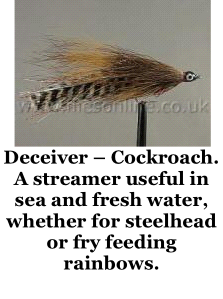 Streamers are a large type of wet fly, primarily tied to imitate the pin fry and larger fry that trout will hunt for. Some people classify streamers as a lure, but it really doesn’t matter how you classify a fly as long as you know when to use it. These flies are fished in a similar way to normal wet flies, but should be fished faster to impart as much movement as possible. On a river, it is best to try a streamer in the shallow, slower moving water where these smaller fry fish are likely to congregate. On still water use a streamer when the trout are actively fry feeding, for example in the autumn when you may see them swirling or crashing around in the shallows. Many streamers may also be used as sea fishing flies, so there is some overlap between the various descriptions of what is a fly.
Streamers are a large type of wet fly, primarily tied to imitate the pin fry and larger fry that trout will hunt for. Some people classify streamers as a lure, but it really doesn’t matter how you classify a fly as long as you know when to use it. These flies are fished in a similar way to normal wet flies, but should be fished faster to impart as much movement as possible. On a river, it is best to try a streamer in the shallow, slower moving water where these smaller fry fish are likely to congregate. On still water use a streamer when the trout are actively fry feeding, for example in the autumn when you may see them swirling or crashing around in the shallows. Many streamers may also be used as sea fishing flies, so there is some overlap between the various descriptions of what is a fly.
Most dry fly hooks have an up-eye, whereas a wet fly hook has a down-eye which helps to pull the fly downwards on retrieve. The hook is also more likely to be forged for strength as weight is not so critical.
